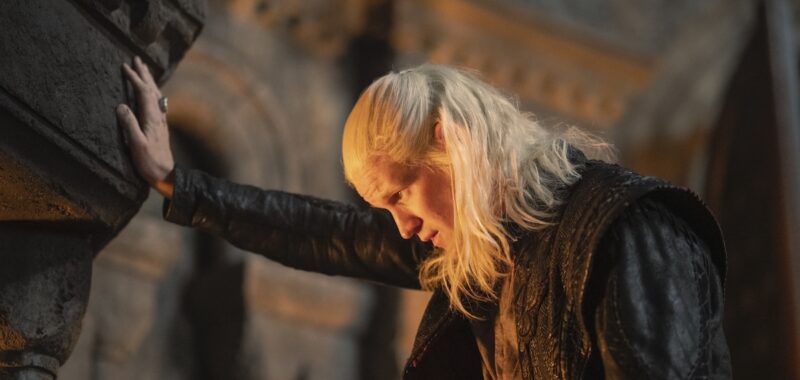We’re now in the back half of House of the Dragon season 2 and—given that I cannot imagine the show will run for more than three seasons—I’d guess we are also in the back half of the series itself. No promises on that front, though: after all, I have been wrong before. It’s a quiet, setting-up-the-chessboard episode that mostly deals with the fallout from the Battle of Rook’s Rest and looks ahead to what book readers know as “the Sowing of the Seeds”—something that gets teased in the final scene. We’ll talk about the ways in which the show is improving upon and deepening some of the less fleshed out portions of Archmaester Gyldayn’s (Fire & Blood’s unreliable in-world narrator) account of this period of the Targaryen dynasty, some of the changes made to that narrative (including a pretty wild turn for Matt Smith’s Daemon), and a bunch of other interesting odds and ends. Spoilers below!
The Title
Episode 5 is entitled “Regent.” Obviously, it refers to the question of who will rule in Aegon’s stead and the sea change that is now occurring as a true monster ascends to the highest station in Westeros. The showrunners had previously confirmed it but, in this episode, we get the first concrete in-world confirmation that Aegon has no male heir. This is a change from Fire & Blood where, in addition to his daughter, Jaehaera, Aegon has a younger son, Maelor, to fill in for the slain Jaehaerys. Maelor is two at the beginning of the Dance so Aemond still ends up being named regent. (Maelor is also, later killed in one of the most stunningly awful events of the entire Targaryen lineage. You seem like nice people so I’ll let the curious among you gorge on cruelty if that’s what you want, and say no more here.) But I suspect that Maelor was cut both because his existence changes nothing about the line of succession in the end and because HotD knew it could only get away with so many scenes of on-screen child deaths before people started refusing to watch.
Unraveling the Opening Credits
No new panels this time around which is, honestly, quite surprising given the Battle of Rook’s Rest last episode. I assume they will update it for next episode (especially given that the hanged rat catchers, who still end the title sequence, are finally cut down this episode). My only guess as to why the they withheld a Rook’s Rest panel is that doing so would confirm (by omission) that Aegon was still alive and they wanted to preserve that tension for the opening ten minutes.
Cutting the Riverlands From Nearly Whole Cloth
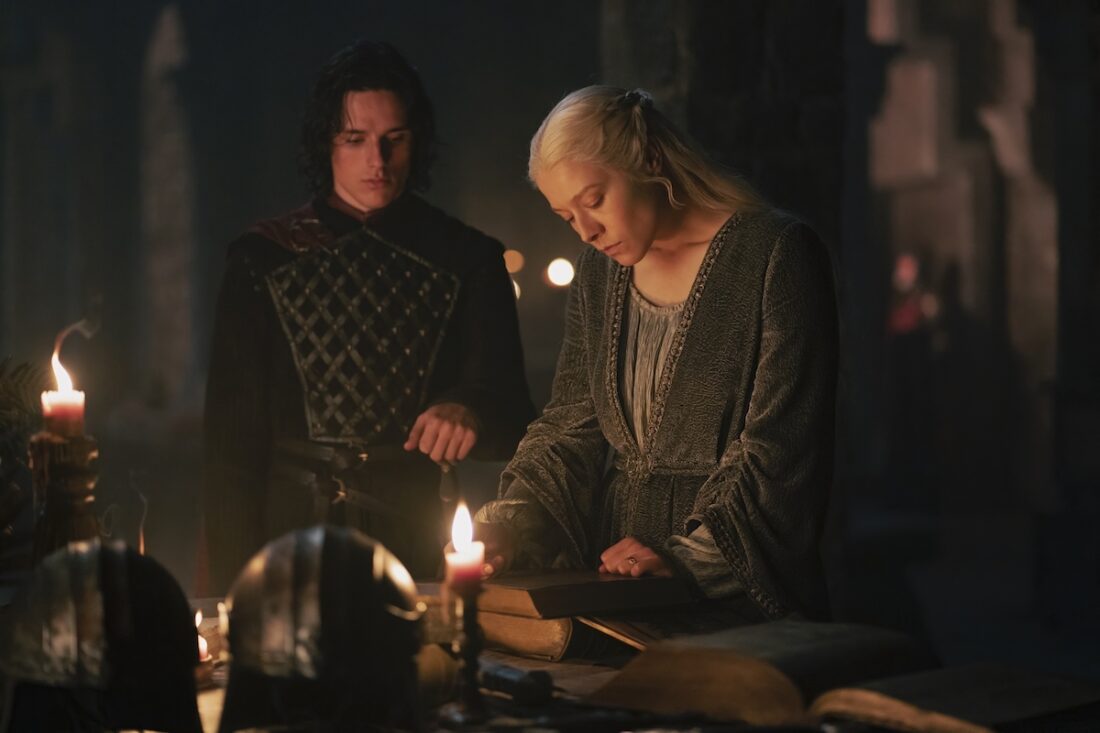
The plot in the Riverlands this episode is close to a complete invention of the show. We’ll talk about Alys Rivers and Daemon in a later section, but the Rogue Prince’s politicking and military strategy is both an expansion on and deviation from some of Archmaester Gyldayn’s reporting on the war.
Martin, via Gyldayn, tells us that “[i]n the Riverlands, raiders out of Raventree, flying Rhaenyra’s banners, crossed into the lands of House Bracken, burning crops, driving off sheep and cattle, sacking villages, and despoiling every sept they came on (the Blackwoods were one of the last houses south of the Neck who still followed the old gods)” (Fire & Blood, 427). In the book, this occurs as a prelude to the Battle of the Burning Mill but the show has moved it afterwards, so that Daemon’s decision to unleash the bloodthirsty Willem Blackwood (Jack Parry-Jones) makes him directly responsible for this savagery. I think I was wrong about Ser Willem, incidentally. It’s probably less that the show wanted to avoid the weirdness of seeing a child as a hardened military leader and more that they needed an unmitigated villain for Daemon to put his faith in. There is plenty of drama about which Riverlands Lords declare for which side, but it does not occur here in the book. Once Daemon takes Harrenhal it’s all over (for now). In expanding this and inventing a few new incidents, the show gives rise to several much more interesting things in return…
First, it gives Jace (Harry Collett) something to do. Gyldayn’s characterization of Rhaenyra (Emma D’Arcy) in the weeks following her son, Lucerys,’ death is of a woman so caught up in grief that she cannot act. The show, wisely, plays Rhaenyra’s grief for a bit, but rewrites her inaction as caution and the desire to only exercise the nuclear option if absolutely necessary. At every turn, as a good friend observed last week, the show is finding ways to make the women at the center of its conflict more active participants who frame the narrative. Everything from Alicent’s (Olivia Cooke) search for the truth about Viserys’ final words to Rhaenys (Eve Best) meeting her husband’s bastard son realigns the show with the experiences of the women at the heart of the story.
But one thing that gets lost in (correctly) placing Rhaenyra back at the center of her own narrative is that her heir, Jacaerys Velaryon, is sidelined; Gyldayn reports that he steps up during Rhaenyra’s absence. The show has turned this into his teenage frustration at not being allowed to act. We’re supposed to like Rhaenyra and, as a result, we should see that she’s raised a smart and capable kid—one who, from birth, was treated like a royal heir (unlike Aegon, Aemond, and Daeron, who only were moved into the line of succession in their teens and early twenties). So it’s a smart move to give Jace the plot point of heading to the Twins to treat with House Frey. It’s also a fun check-in with one of the most detested houses in Westeros (even if Martin is pretty clear that the Freys’ villainy stems from Lord Walder in the GoT era) and it reminds us that Cregan Stark (Tom Taylor) and his two thousand graybeards are still marching South. It’s precisely the sort of military detail that Gyldayn glosses over but makes the strategy of the war feel real. In a world with swift-flying, army-destroying dragons, it can be easy to forget that armies of men still have to maneuver through a continent roughly the size of South America, and that the realities of waging war are more often about supply lines and timing than actual strength of arms.
The other thing that this Riverlands plot offers us is a long look at Daemon’s capabilities as a ruler. Martin has said in interviews that Daemon Targaryen is the most morally gray figure out of the whole family line—equally villainous and heroic. No offense to Martin, but I’m not entirely sure that the morally gray Daemon is much on display in F&B, and the show has gone even farther in villainizing him. For example, the show (I think wisely) pins the horrific Blood and Cheese incident on Daemon’s impulsive decision to try and enact vengeance on his niece-wife’s behalf. In the book, as hinted above, he is already en route to Harrenhal. And now, we see Viserys and Rhaenyra’s misgivings come true: Daemon is a terrible leader. Whatever his prowess in combat and whatever his shrewdness about wanting seasoned, devoted men behind him (as demonstrated by his desire to fight alongside the Brackens rather than merely destroy them), his plot with Ser Willem utterly backfires. Near the episode’s end, Daemon is confronted by a group of aggrieved Riverlands nobility including (I’m pretty sure) Lady Mallister (Anna Francolini), Lord Walys Mooton (Turlough Convery), Lord Darry (John-Paul Hurley) and an unknown lord played by Antonio Magro (if they plan to use Lords who play a role in the Dance, he could be a Piper, Vance, Butterwell, Grey, Deddings, Charlton, or Chambers). They report that Willem has been flying Rhaenyra’s banners as they defile septs and pillage the countryside. It’s an obvious outcome but one that Daemon wasn’t able to anticipate or even imagine. We have always known that Daemon is a problem—but it’s nice to have the show confirm that he would make for an absolutely abysmal king.
It also has an echo of the later ASoIaF books as one of Tywin Lannister’s primary tactics is to set his “mad dogs”—Gregor Clegane, Amory Lorch, and the Bloody Mummers—loose on the Riverlands to stir up trouble while maintaining some degree of plausible deniability. The difference between Tywin and Daemon, however, is that the former has no interest in being loved by his subjects and doesn’t have a reputation as a child-murderer to defend himself against.
The Fallout From Rook’s Rest
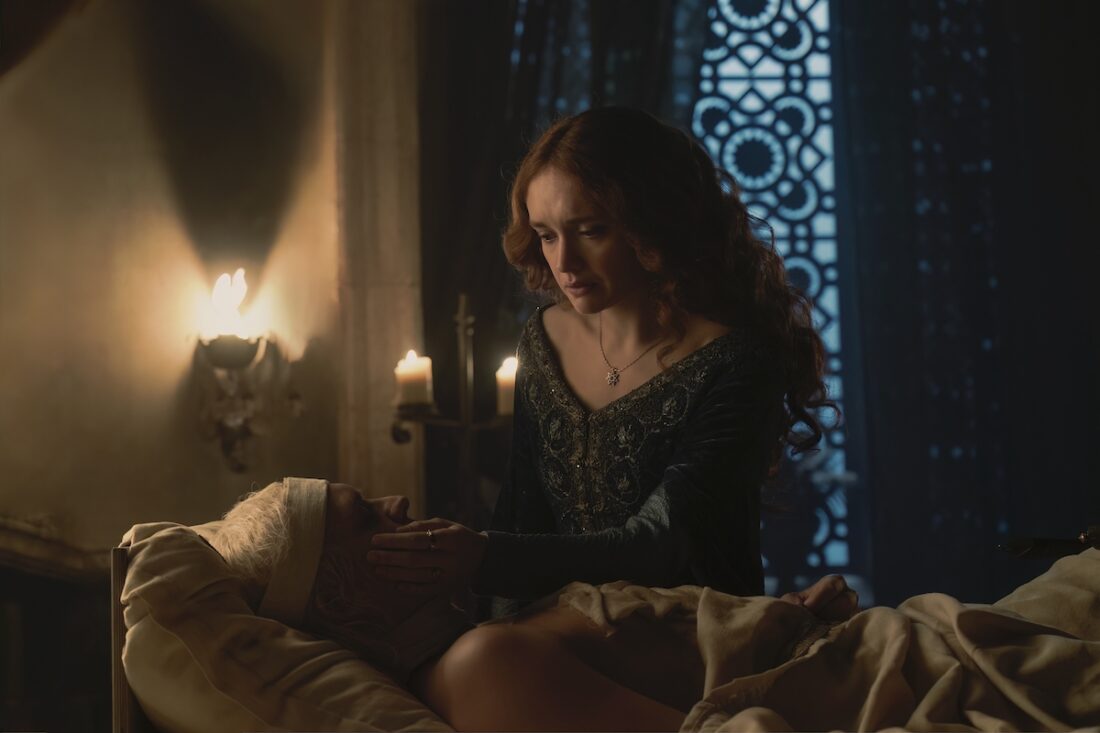
In Fire & Blood, Rhaenyra is still absent, grieving for Lucerys, when the Battle of Rook’s Rest occurs. Afterwards, wracked with grief, Corlys Velryon (Steve Toussaint) tells Rhaenyra “It should have been you […] Staunton sent to you, yet you left it to my wife to answer and forbade your sons to join her” (Fire & Blood, 438). By contrast, the show made Rhaenys the architect of her own fate, had her volunteer in front of Corlys, and have eschewed the plotline wherein Rhaenyra is blamed for getting the Queen Who Never Was killed. As happens often when a GoT show makes a consciously contradictory choice in their adaptation, they even wink at it with Mysaria (Sonoya Mizuno) asking if they blame her and Rhaenyra answering “I’d rather they had.”
This sets up a mourning period for Rhaenys that moves across the entirety of the episode. The show did an expert job of maneuvering her to the center of the narrative and killing her off when it was the most painful, and much of this episode is about those reverberations being felt. It makes for a great change in numerous characters. They use it to underscore Rhaena Targaryen’s (Phoebe Campbell) deep loneliness in the Eyrie as she speaks with her cousin-in-law, Jeyne Arryn (Raised by Wolves’ Amanda Collin). The Eyrie has always been a place of live burial and entombed loneliness (you can read all about it in my 2019 article on the Gothic and Sansa Stark) but having Rhaenys’ death still be so fresh and raw as her granddaughter arrives really adds bite to the scene. Rhaena’s twin, Baela (Bethany Antonia) gets even more of a chance to play out Rhaenys’ loss by speaking with Rhaenyra about the towering figure that Rhaenys cut and the complicated legacy she’s left behind.
This comes to a head when Baela offers her grandfather, Lord Corlys, the position of Rhaenyra’s Hand. I was convinced that the show would play Corlys’ misogyny to the very end, denying Rhaena the position of Lord of the Tides as a sign of his lack of understanding about his late wife and her strength. Once again, the show makes the more interesting and exciting choice: Corlys tries to make Baela his heir, both as a way to make amends to Rhaenys and as a recognition of her strength, which he now sees. It’s too late for that. Baela is engaged to the heir to the throne and is much more a Targaryen than a Velaryon. There is something the tiniest bit pitiable about Lord Corlys’ politics evolving only in his grief, but it is also a testament to Rhaenys’ power and legacy that, here, in the wake of her death, her husband realizes that all his legitimate children and grandchildren have been dragonriders, her influence far greater than his.
The Witch Queen of Harrenhal
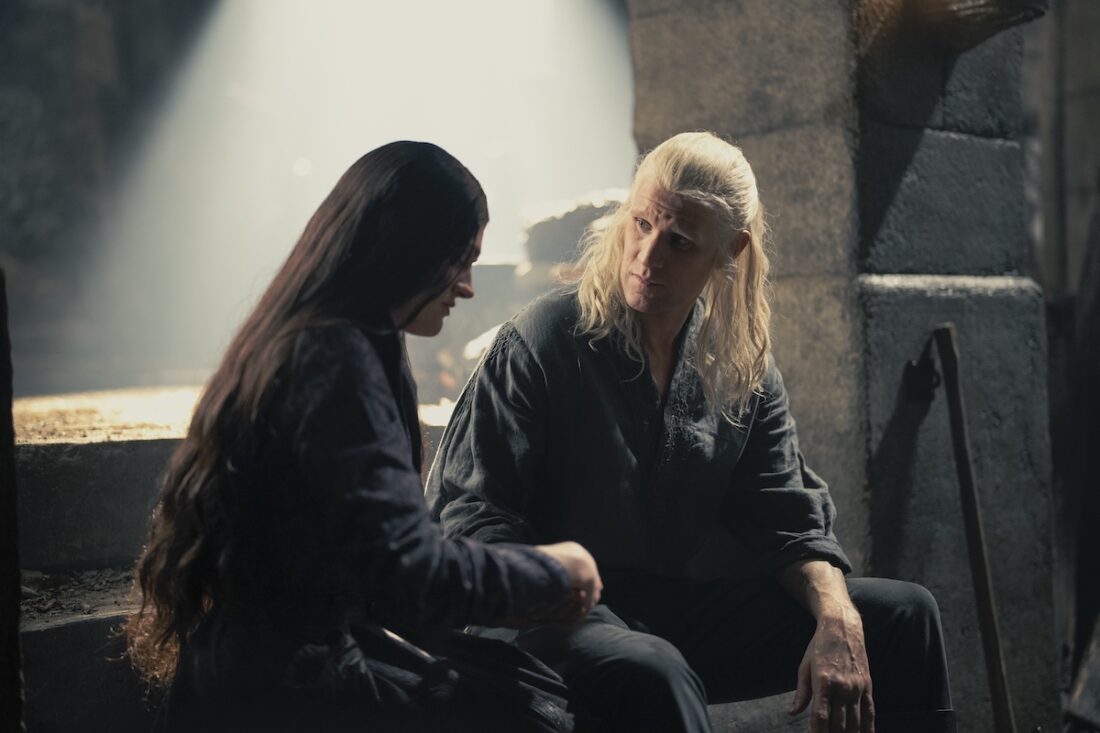
As Daemon continues to slip into madness, he continues to dream of the women in his life. Up until now, he has only dreamed about his wives—Laena (Nana Blondell) and Rhaenyra (Milly Alcock) but now he has a long, distressing sex dream about his dead mother, Alyssa Targaryen (Emeline Lambert). There is this strange, witchy maiden-mother-crone thing going on with the women he sees here (though, obviously, all of these women appear to him in the prime of their lives), as Daemon flirts with the idea of taking the throne for himself and allows Willem Blackwood to attack women and children in pursuit of that end. Which brings us back to Alys Rivers once again. Last episode she said she was a barn owl given human form—which is played as a joke but may also be a bit of truth about her warging into various woodland beasts. Gayle Rankin herself has intimated that Alys is four hundred years old which means that, at the very least, the showrunners have teased the possibility behind the scenes.
The irrepressible geek-culture YouTuber Erik Voss has been an enthusiastic proponent of a particular fan theory that the show seems to be leaning into: that Alys Rivers is not merely the immortal Witch Queen of Harrenhal but also a very specific witch from later in the timeline. In 259 AC (130 years after the events of HotD and fortyish years before GoT), most of the Royal Targaryens are killed in a fire that sweeps through the family summer palace, Summerhall. It has been speculated that the fire might have been connected to a botched spell to resurrect dragons and that some of that magic might have alighted on Rhaegar Targaryen who was born the night of the tragedy. In any case, it changed the line of succession to place Rhaegar and Daenerys’ father, the “Mad King” Aerys II, on the throne and marks the end of the second Targaryen golden age (the Dance of the Dragons is the end of the first). One of the few survivors of the fire was Jenny, a mysterious girl from the ruined castle of Oldstones who married Aerys II’s uncle, Duncan Targaryen. This is the same Jenny of Oldstones who is immortalized in the haunting song which features in the very best episode of the later seasons of Game of Thrones. Jenny is remembered as a strange, sad girl but she brought a friend with her to court: an elderly, diminutive woman with albinism said to have the gift of prophecy. This same woman meets with Beric Dondarrion and Arya Stark during A Storm of Swords, where she foretells the Red Wedding among numerous other events and is referred to as “the Ghost of High Heart.” High Heart is quite close to Harrenhal and it is this ancient woods witch that Voss and others believe might be Alys Rivers. It certainly doesn’t feel impossible.
DragonWatch
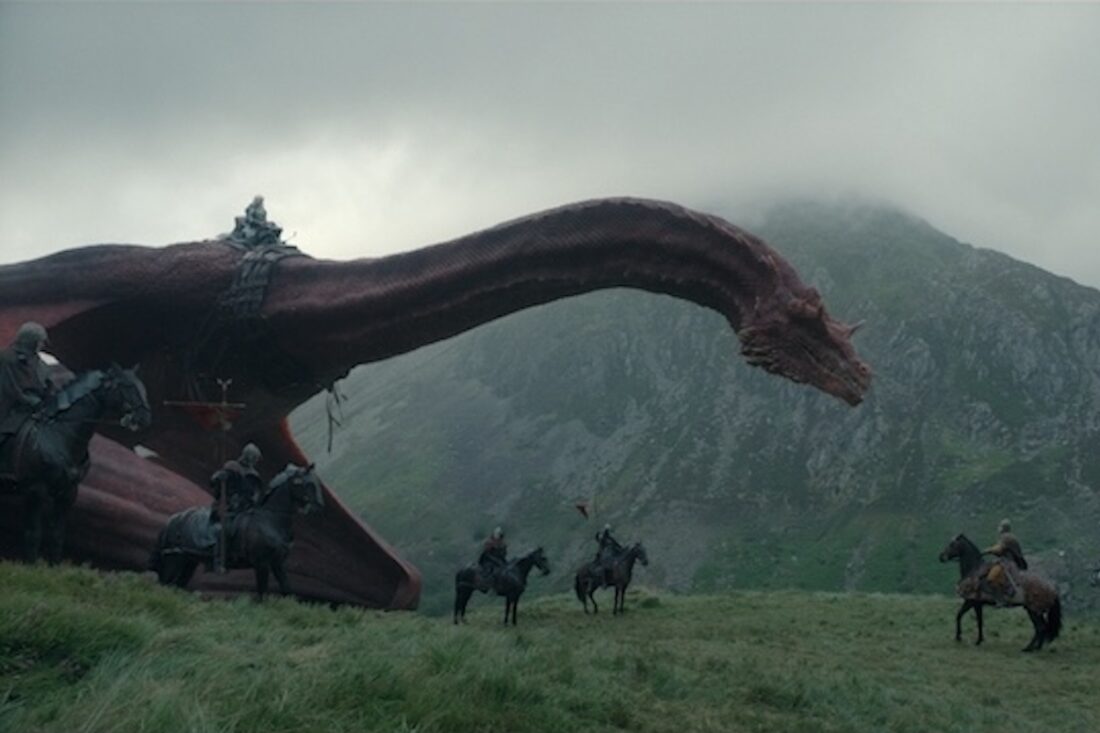
Not a ton of dragons on screen in this episode (though last week’s glut should probably last us for a while). But we do get a couple sightings:
Caraxes — We have not yet discussed Caraxes, the Blood Wyrm who, though he has been on the show since the very first episode, has a couple of great shots in this episode showcasing his size and bizarre shape. As I mentioned in last week’s write-up, Caraxes was originally ridden by Aemon Targaryen, Rhaenys’ father and heir to the throne until his untimely death during a skirmish with the Dornish. We know that Caraxes was rideable in 72 AC, which means he is at least fifty-seven years old and potentially in his mid-sixties. We don’t know what the name means but it does sound vaguely like High Valyrian. He gets his nickname, the Blood Wyrm, from his bright red coloring. The show has also emphasized the “wyrm” part of his nature by giving him a long, serpentine neck. The show has also given him a deviated septum that results in a high pitched, trilling cry. He’s about the half the size of Vhagar, making him the largest dragon currently ridden in the Black faction. Other than Vhagar, Caraxes is the most battle-tested dragon in Westeros, having fought in the Stepstones under Daemon and during the Fourth Dornish War under Aemon. Tragically, Caraxes was also known to have a companionable relationship with Meleys and Vhagar, as the three royal siblings of the previous generation—Aemon, Alyssa, and Baelon—flew their respective dragons together.
Vermax — Jacaerys Velaryon’s dragon is large enough to ride but relatively small by the standards of battle-tested dragons. He is the product of the royal Targaryen tradition of placing dragon eggs in the cribs of infant Targaryens. During this era of history, there was enough of a surplus of eggs and enough fire magic in the world that many of the eggs hatched. Other dragons birthed via this process include Lucerys’ dragon, Arrax, Joffrey’s dragon, Tyraxes, Aegon Velaryon’s dragon, Stormcloud, and, presumably–though unconfirmed—Rhaenyra’s dragon, Syrax, Baela’s dragon, Moondancer, Daeron’s dragon, Tessarion, and Aegon’s dragon, Sunfyre. This would make Vermax somewhere between twelve and sixteen years old by the time of the show (though perhaps, he has been aged up, like Jace himself, to be between sixteen and twenty). We aren’t given an etymology for his name, but it follows High Valyrian naming conventions. Syrax and Meraxes are both the names of gods in Old Valyria, so it’s possible Vermax is as well. He’s undescribed in F&B, but the show has given him dark green scales, orange wing membranes and fins, and pale, translucent horns. Like all the dragons mentioned above, he’s only ever had a single rider.
Odds and Ends
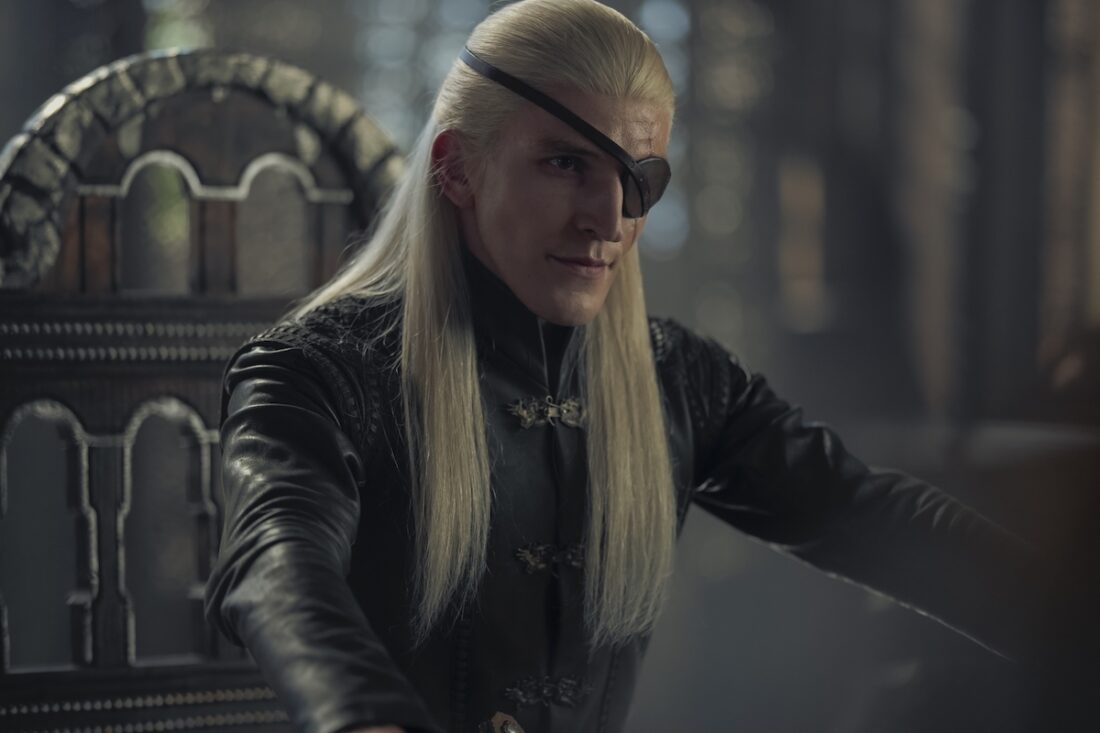
- The King’s Landing herald is played by British hip-hop/spoken word artist and actor Scroobius Pip, continuing the legacy of GoT shows casting musicians in cameos.
- Composer Ramin Djawadi plays a mournful single violin version of the King’s leitmotif as Aegon is brought into the Red Keep.
- In Aegon’s sick room, Alicent looks over to a group of septas with banners on their shoulders. These are the Silent Sisters, brides of the Stranger who, in the faith of the Seven, take vows of silence and prepare the dead for internment. Their presence, hovering at the back of the room, might as well be a flock of waiting vultures.
- The show has styled Ser Simon Strong (Sir Simon Russel Beale) with an approximation of George R.R. Martin’s facial hair and dressed him in robes that seemingly allude to Martin’s penchant for loudly patterned, brilliantly colored vests. The actors are also both the same relatively diminutive height (5’6”) and of similar builds. This feels more and more intentional given how much Ser Simon talks about the food—one of Martin’s most vivid prose interests. I heartily approve.
- In F&B, Aegon’s armor is partially melted onto his body, meaning he can never remove it. It’s a great visual detail, but falls into the category of slightly more medically improbable things Martin writes into his realism-adjacent fantasy. Grand Maester Orwyle explains the change in the show by reminding us that Valyrian steel has an absurdly high melting point (also true in the books) which accounts for Aegon being badly burned by, but not fused into, his namesake’s battle regalia.
- They seem to finally be advancing Alicent’s slow awakening to the realities of the patriarchy with the majority of her small council, including Ser Criston and Lord Larys choosing to install Aemond as regent. It’s another testament to Olivia Cooke’s skill that she puts so much into the long, slow shot of her quietly bristling and silently freaking out as the meeting continues as though she weren’t there.
- Kat (Ellora Torchia), says that her brother lives in Tumbleton—a market town Southwest of King’s Landing, just on the other side of the border between the Crownlands and the Reach. In F&B, no mention is made of Hugh Hammer having a family of any kind, but there are some later events that involve him and Tumbleton, so it’s neat that the show is introducing us to the existence of the town early on and that, when those events come to pass in the show, his brother-in-law might be in residence.
- Excellent costuming note: Alicent has Hightower sigil-shaped earrings.
- Lord Forrest Frey is considerably younger in F&B, and has not yet married Sabitha Vypren (Sarah Woodward). The Vyprens are a minor Riverlands house. It’s just nice to see a Lady Frey get some actual respect and power on a GoT show.
- I love the staging of Jace meeting the Freys at the midway point of the bridge that spans the Green Fork. The fact that the table they drink at is a shut door feels both a little too on the nose and also vaguely delicious.
- Book readers know that, in addition to this plot with Daemon’s misrule being an invention of the show, a lot of Alys Rivers’ plot, thus far, has been partially transposed from her relationship with a different character. I won’t spoil that here, but it remains to be seen if they are changing it entirely or if she will also retain her later plot.
- There is an excellent detail where the chairs in Ser Simon’s solarium in Harrenhal have faded frescoes of people on them that almost look like burned bodies—a metonymy for the burning of King Harren Hoare, Harrenhal’s builder, who was killed by Balerion’s dragonfire. Among my favorite paintings is Giorgione’s 1508 fresco of a nude woman. It’s beautiful, in part, because it has been so desperately damaged—a perfectly gothic aesthetic of ruin and decay. It feels as though the Harrenhal chairs took some inspiration from that fresco or works like it.
- The new river lords are not yet identified by full names on IMDB. That said, Manfryd Mooton is the only Mooton of note in this time period. There is a relatively unimportant (from Gyldayn’s perspective) Lord Jorah Mallister in the historical record; it’s unclear if the show has merged Lady Mallister with Jorah or if she is his mother, sister, or wife. We also have no first name for Lord Darry.
- Dyana (Maddie Evans), the serving girl at Sylvi’s brothel, returns for the second time this season. In season one, she came to Alicent after Aegon had sexually assaulted her and the Queen dowager gave her moon tea and urged her silence. Whatever Mysaria has planned for her and Elinda Massey (Jordon Stevens), it’s probably going to further aggravate the smallfolk.
- Helaena (Phia Saban) asks the now-Prince Regent, Aemond, “was it worth the price?” It’s a lot less of a prophetic leap for her to think that Aemond had something to do with Aegon’s maiming, but it does force us to look back to episode three and wonder what she meant when Helaena told Alicent that she forgives her.
In Conclusion
Obviously, we needed an episode to recover from the dizzying highs of last week’s “The Red Dragon and the Gold.” But this was still a solid episode, filled with some particularly intriguing wrinkles for book readers. It also provides a solid set-up for what I assume will be the “Sowing of the Seeds” in Episode 6. That, I assume, is going to be another huge, dragon-heavy episode…
Only three episodes left this season: What did you think? Do you enjoy these breaks from the action or does it feel like place-setting? Are you all in on the immortal Alys Rivers theory or do you think the show will keep her arc a little more down to earth? Let me know in the comments!

